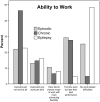The stigma of migraine
- PMID: 23342079
- PMCID: PMC3546922
- DOI: 10.1371/journal.pone.0054074
The stigma of migraine
Abstract
Background: People who have a disease often experience stigma, a socially and culturally embedded process through which individuals experience stereotyping, devaluation, and discrimination. Stigma has great impact on quality of life, behavior, and life chances. We do not know whether or not migraine is stigmatizing.
Methods: We studied 123 episodic migraine patients, 123 chronic migraine patients, and 62 epilepsy patients in a clinical setting to investigate the extent to which stigma attaches to migraine, using epilepsy as a comparison. We used the stigma scale for chronic illness, a 24-item questionnaire suitable for studying chronic neurologic diseases, and various disease impact measures.
Results: Patients with chronic migraine had higher scores (54.0±20.2) on the stigma scale for chronic illness than either episodic migraine (41.7±14.8) or epilepsy patients (44.6±16.3) (p<0.001). Subjects with migraine reported greater inability to work than epilepsy subjects. Stigma correlated most strongly with the mental component score of the short form of the medical outcomes health survey (SF-12), then with ability to work and migraine disability score for chronic and episodic migraine and the Liverpool impact on epilepsy scale for epilepsy. Analysis of covariance showed adjusted scores for the stigma scale for chronic illness were similar for chronic migraine (49.3; 95% confidence interval, 46.2 to 52.4) and epilepsy (46.5; 95% confidence interval, 41.6 to 51.6), and lower for episodic migraine (43.7; 95% confidence interval, 40.9 to 46.6). Ability to work was the strongest predictor of stigma as measured by the stigma scale for chronic illness.
Conclusion: In our model, adjusted stigma was similar for chronic migraine and epilepsy, which were greater than for episodic migraine. Stigma correlated most strongly with inability to work, and was greater for chronic migraine than epilepsy or episodic migraine because chronic migraine patients had less ability to work.
Conflict of interest statement
Figures



Similar articles
-
An invisible cause of disability: stigma in migraine and epilepsy.Neurol Sci. 2022 Jun;43(6):3831-3838. doi: 10.1007/s10072-022-05888-1. Epub 2022 Jan 15. Neurol Sci. 2022. PMID: 35034235
-
A comparative study of health related quality of life, psychological well-being, impact of illness and stigma in epilepsy and migraine.Seizure. 2011 Nov;20(9):679-85. doi: 10.1016/j.seizure.2011.06.017. Epub 2011 Jul 20. Seizure. 2011. PMID: 21764337
-
Underrecognition of migraine-related stigmatizing attitudes and social burden: Results of the OVERCOME Japan study.Brain Behav. 2024 Jul;14(7):e3547. doi: 10.1002/brb3.3547. Brain Behav. 2024. PMID: 39054258 Free PMC article.
-
Migraine: Stigma in Society.Curr Pain Headache Rep. 2019 Feb 9;23(1):8. doi: 10.1007/s11916-019-0743-7. Curr Pain Headache Rep. 2019. PMID: 30739216 Review.
-
Chronic disorders with episodic manifestations: focus on epilepsy and migraine.Lancet Neurol. 2006 Feb;5(2):148-157. doi: 10.1016/S1474-4422(06)70348-9. Lancet Neurol. 2006. PMID: 16426991 Free PMC article. Review.
Cited by
-
The Role of Anti-calcitonin Gene-related Peptide in Migraine and its Implication in Developing Countries: A Reasonable Option to Consider Despite Higher Cost.Cureus. 2019 Jun 1;11(6):e4796. doi: 10.7759/cureus.4796. Cureus. 2019. PMID: 31396466 Free PMC article. Review.
-
Portrayals of narcolepsy from 1980 to 2020: a descriptive analysis of stigmatizing content in newspaper articles.J Clin Sleep Med. 2022 Jul 1;18(7):1769-1778. doi: 10.5664/jcsm.9966. J Clin Sleep Med. 2022. PMID: 35332869 Free PMC article.
-
Relationships between headache frequency, disability, and disability-related unemployment among adults with migraine.J Manag Care Spec Pharm. 2023 Feb;29(2):197-209. doi: 10.18553/jmcp.2023.29.2.197. J Manag Care Spec Pharm. 2023. PMID: 36705286 Free PMC article.
-
When Mom Has Migraine: An Observational Study of the Impact of Parental Migraine on Adolescent Children.Headache. 2019 Feb;59(2):224-234. doi: 10.1111/head.13433. Epub 2018 Oct 31. Headache. 2019. PMID: 30378682 Free PMC article.
-
An invisible cause of disability: stigma in migraine and epilepsy.Neurol Sci. 2022 Jun;43(6):3831-3838. doi: 10.1007/s10072-022-05888-1. Epub 2022 Jan 15. Neurol Sci. 2022. PMID: 35034235
References
-
- Goffman E (1963) Stigma: notes on the management of spoiled identity. New York: Simon and Schuster.
-
- Koller M, Kussman J, Lorenz W, Jenkins M, Voss M, et al. (1996) Symptom reporting in cancer patients: the role of negative affect and experienced social stigma. Cancer 77: 983–995. - PubMed
-
- Link BG, Phelan JC (2001) Conceptualizing stigma. Ann Rev Sociol 27: 363–385.
-
- Walton GM, Cohen GL (2011) A brief social-belonging intervention improves academic and health outcomes of minority students. Science 331: 1447–1451. - PubMed
MeSH terms
LinkOut - more resources
Full Text Sources
Other Literature Sources
Medical

